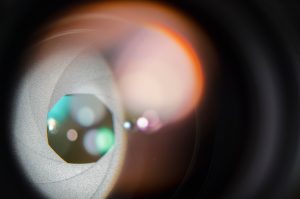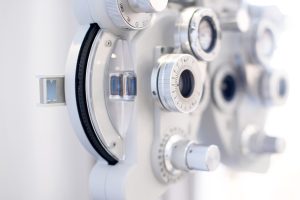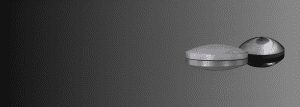Aspherical Lenses
Avantier designs and manufactures precision aspherical lenses for advanced optical applications across industries including:- Manufacturing
- Aerospace and defense
- Medical and life sciences
- Scientific instrumentation
- Consumer electronics
Key Types of Aspheric Lenses
Avantier offers a wide range of high-performance aspheric lens solutions:- Infrared Germanium Aspheric Lenses – Optimized for LWIR and MWIR thermal imaging systems.
- Plastic & Acrylic Molded Aspheres – Lightweight and cost-effective, ideal for AR/VR and consumer electronics.
- Laser-Grade Aspheric Lenses – Precision beam shaping with low aberration, for laser collimation and focusing.
- High Precision Diffractive Aspheres – Combine refractive and diffractive designs for superior chromatic correction.
Factory Standard (Manufacturing Capability)
Avantier’s in-house production delivers exceptional surface precision and quality across a wide range of specifications:
| Diameter | 5 – 200mm |
| Diameter Tolerance | +0/-0.100mm – +0/-0.010mm |
| Asphere Figure Error (P – V) | 3μm – smaller than 0.06μm |
| Vertex Radius (Asphere) | ±0.5% – ±0.05% |
| Sag | 25mm max |
| Typical Slope Error | 1μm – 0.15μm per 1mm window |
| Centering (Beam Deviation) | 3 arcmin – 0.5 arcmin |
| Center Thickness Tolerance | ±0.100mm – ±0.010mm |
| Surface Quality (Scratch Dig) | 80-50, 40-20,10-5 |
| Aspheric Surface Metrology | Profilometry (2D & 3D) & Interferometry |
Custom Aspheric Lenses
Avantier’s optical engineering team partners with clients to develop custom aspheric lenses that meet critical project requirements:
- Optical glass, fused silica, germanium, and plastic materials
- Diameters from sub-millimeter up to 200+ mm
- Diamond turning, CNC polishing, and precision molding
- Fully customizable AR, HR, IR, UV coatings
Used across applications such as:
- Biomedical and life sciences
- Aerospace and defense imaging
- High-power laser systems
- Semiconductor and industrial metrology
- Optical sensors and consumer electronics
Aspherical Lenses Material Selection
The choice of materials for aspherical lenses is influenced by factors such as wavelength requirements and manufacturing cost. The following summarizes materials compatible with each manufacturing process.
| Manufacturing of Aspheric Lenses | Capabilities of Materials |
| Diamond Turning | Ge, Si, ZnSe, ZnS, Plastics |
| Grinding and Polishing | Optical glass (CDGM, Hoya, Ohara, Schott), Fused Silica, Low Temperature Optical Glass, Plastics, Ge, Si, ZnSe and ZnS |
| Precision Glass Molding | Low Temperature Optical Glass, Optical glass (CDGM, Hoya, Ohara, Schott) with restrictions, Plastics |
| Injection Molding of Plastics | Low Temperature Optical Glass, Optical glass (CDGM, Hoya, Ohara, Schott) with restrictions, Plastics |
Stock Aspheric Lenses
Avantier maintains a comprehensive inventory of stock aspheric lenses for rapid delivery. These lenses cover a broad range of focal lengths, diameters, and materials, including laser-grade and uncoated optics.
Stock – Aspheric Lenses
| Part Number | Focal length (mm) | Back Focal length (mm) | Diameter (mm) | Thickness (mm) | Material | Price (USD) |
|---|---|---|---|---|---|---|
| AVTJF-0001 | 3.1 | 1.9 | 5.0 | 2.0 | H-F4 | $20.00 |
| AVTJF-0002 | 3.7 | 2.4 | 5.0 | 2.0 | H-K51 | $20.00 |
| AVTJF-0003 | 4.0 | 1.4 | 5.0 | 3.9 | H-K51 | $20.00 |
| AVTJF-0004 | 5.6 | 3.3 | 8.0 | 4.0 | H-ZK2 | $20.00 |
| AVTJF-0005 | 6.0 | 4.2 | 6.7 | 2.8 | H-K51 | $20.00 |
| AVTJF-0006 | 6.5 | 3.2 | 10.0 | 5.0 | H-K51 | $20.00 |
| AVTJF-0007 | 6.6 | 4.3 | 7.5 | 3.5 | H-K51 | $20.00 |
| AVTJF-0008 | 7.4 | 4.8 | 8.5 | 4.0 | H-K51 | $20.00 |
| AVTJF-0009 | 7.5 | 4.6 | 12.0 | 5.5 | H-K51 | $20.00 |
| AVTJF-0010 | 7.6 | 4.0 | 13.0 | 6.3 | H-K51 | $20.00 |
| AVTJF-0011 | 8.0 | 3.5 | 10.0 | 6.8 | H-K51 | $20.00 |
| AVTJF-0012 | 8.0 | 3.7 | 12.7 | 7.5 | H-K51 | $20.00 |
| AVTJF-0013 | 8.1 | 2.9 | 15.0 | 8.5 | H-K51 | $20.00 |
| AVTJF-0014 | 8.3 | 5.6 | 16.0 | 7.0 | H-K9L | $25.00 |
| AVTJF-0015 | 8.5 | 8.0 | 12.0 | 5.6 | H-K51 | $30.00 |
| AVTJF-0016 | 9.0 | 8.0 | 6.3 | 1.7 | H-K51 | $20.00 |
| AVTJF-0017 | 10.0 | 4.9 | 12.5 | 7.7 | H-K51 | $20.00 |
| AVTJF-0018 | 10.4 | 7.4 | 12.0 | 5.6 | H-K51 | $20.00 |
| AVTJF-0019 | 10.5 | 7.2 | 12.0 | 6.0 | H-K51 | $20.00 |
| AVTJF-0020 | 11.0 | 6.0 | 16.0 | 8.0 | H-F4 | $20.00 |
| AVTJF-0021 | 11.1 | 5.0 | 19.9 | 10.9 | H-K51 | $25.00 |
| AVTJF-0022 | 12.0 | 6.3 | 15.0 | 8.6 | H-K51 | $20.00 |
| AVTJF-0023 | 12.4 | 9.5 | 12.0 | 4.5 | H-K51 | $20.00 |
| AVTJF-0024 | 12.5 | 7.1 | 20.0 | 9.0 | H-ZF2 | $200.00 |
| AVTJF-0025 | 13.5 | 8.6 | 18.0 | 7.4 | H-K51 | $20.00 |
| AVTJF-0026 | 14.0 | 10.2 | 12.9 | 5.7 | H-K9L | $20.00 |
| AVTJF-0027 | 15.0 | 10.0 | 20.0 | 9.0 | H-K51 | $20.00 |
| AVTJF-0028 | 15.3 | 14.6 | 24.0 | 9.0 | H-F3 | $25.00 |
| AVTJF-0029 | 15.3 | 10.7 | 18.0 | 7.0 | H-K9L | $25.00 |
| AVTJF-0030 | 16.0 | 9.1 | 20.0 | 10.5 | H-K51 | $20.00 |
| AVTJF-0031 | 16.0 | 7.3 | 25.4 | 14.0 | H-K51 | $25.00 |
| AVTJF-0032 | 16.3 | 10.4 | 20.0 | 9.0 | H-K9L | $200.00 |
| AVTJF-0033 | 16.4 | 12.8 | 20.0 | 6.4 | H-K51 | $20.00 |
| AVTJF-0034 | 16.7 | 9.5 | 24.9 | 11.0 | H-K51 | $20.00 |
| AVTJF-0035 | 17.4 | 12.2 | 20.0 | 8.3 | H-K51 | $20.00 |
| AVTJF-0036 | 18.0 | 11.2 | 24.0 | 10.4 | H-K51 | $25.00 |
| AVTJF-0037 | 18.3 | 11.4 | 30.0 | 14.0 | H-K51 | $25.00 |
| AVTJF-0038 | 19.0 | 15.7 | 12.0 | 5.0 | H-K51 | $20.00 |
| AVTJF-0039 | 19.4 | 14.5 | 26.0 | 9.1 | H-K51 | $25.00 |
| AVTJF-0040 | 19.7 | 12.9 | 24.0 | 10.4 | H-K51 | $25.00 |
| AVTJF-0041 | 19.9 | 11.8 | 25.0 | 12.3 | H-K51 | $20.00 |
| AVTJF-0042 | 21.6 | 11.0 | 34.9 | 19.0 | H-K51 | $25.00 |
| AVTJF-0043 | 23.5 | 15.0 | 32.5 | 13.5 | H-K51 | $25.00 |
| AVTJF-0044 | 24.0 | 14.7 | 30.0 | 14.1 | H-K51 | $20.00 |
| AVTJF-0045 | 25.0 | 19.4 | 25.0 | 8.5 | H-K51 | $20.00 |
| AVTJF-0046 | 25.6 | 16.7 | 30.0 | 13.5 | H-K51 | $20.00 |
| AVTJF-0047 | 26.8 | 20.2 | 30.0 | 10.0 | H-K51 | $25.00 |
| AVTJF-0048 | 28.5 | 18.6 | 40.0 | 15.0 | H-K9L | $40.00 |
| AVTJF-0049 | 29.4 | 20.3 | 35.0 | 13.9 | H-K51 | $30.00 |
| AVTJF-0050 | 29.5 | 20.9 | 40.0 | 15.5 | H-K9L | $40.00 |
| AVTJF-0051 | 30.0 | 19.0 | 38.4 | 19.0 | H-K51 | $25.00 |
| AVTJF-0052 | 32.0 | 17.0 | 50.8 | 25.0 | H-K51 | $30.00 |
| AVTJF-0053 | 32.0 | 20.9 | 45.0 | 18.5 | H-K51 | $30.00 |
| AVTJF-0054 | 32.0 | 20.3 | 40.0 | 11.8 | H-K51 | $20.00 |
| AVTJF-0055 | 35.8 | 24.8 | 50.0 | 16.7 | H-K51 | $35.00 |
| AVTJF-0056 | 39.8 | 25.6 | 60.0 | 26.0 | H-K51 | $45.00 |
| AVTJF-0057 | 40.0 | 26.0 | 50.0 | 21.4 | H-K51 | $25.00 |
| AVTJF-0058 | 49.2 | 29.5 | 75.0 | 30.0 | H-K51 | $45.00 |
Stock - Uncoated Aspheric Lenses
| Part Number | Description | Dia. (mm) | EFL (mm) | NA | BFL (mm) | Substrate | Centering (arcmin) | CA (mm) | ET (mm) | CT (mm) | F/# | Shape of Back Surface | Wavelength Range (nm) | Price (USD) |
|---|---|---|---|---|---|---|---|---|---|---|---|---|---|---|
| AVTMF-0001 | 10mm Dia, 0.50 Numerical Aperture Uncoated | 10.00 +0.0/-0.1 | 10.00 @ 587.6nm | 0.50 | 7.48 | L-BAL35 | ≤5 | 9.00 | 1.69 | 4.00 ±0.1 | 1.00 | Plano | 330 – 2400 | $170.00 |
| AVTMF-0002 | 10mm Dia, 0.67 Numerical Aperture Uncoated | 10.00 +0.0/-0.1 | 7.50 @ 587.6nm | 0.67 | 4.51 | N-SF5 | ≤5 | 9.00 | 2.21 | 5.00 ±0.1 | 0.75 | Plano | 380 – 2500 | $170.00 |
| AVTMF-0003 | 12.5mm Dia, 0.50 Numerical Aperture Uncoated | 12.50 +0.0/-0.1 | 12.50 @ 587.6nm | 0.50 | 9.35 | L-BAL35 | ≤5 | 11.25 | 2.11 | 5.00 ±0.1 | 1.00 | Plano | 330 – 2400 | $190.00 |
| AVTMF-0004 | 12.5mm Dia, 0.66 Numerical Aperture Uncoated | 12.50 +0.0/-0.1 | 9.50 @ 587.6nm | 0.66 | 6.51 | N-SF5 | ≤5 | 11.25 | 1.60 | 5.00 ±0.1 | 0.76 | Plano | 380 – 2500 | $190.00 |
| AVTMF-0005 | 15mm Dia., 0.33 Numerical Aperture Uncoated | 15.00 +0.0/-0.1 | 22.50 @ 587.6nm | 0.33 | 19.98 | L-BAL35 | ≤5 | 13.50 | 1.80 | 4.00 ±0.1 | 1.50 | Plano | 330 – 2400 | $210.00 |
| AVTMF-0006 | 15mm Dia., 0.40 Numerical Aperture Uncoated | 15.00 +0.0/-0.1 | 18.75 @ 587.6nm | 0.40 | 15.92 | L-BAL35 | ≤5 | 13.50 | 1.82 | 4.50 ±0.1 | 1.25 | Plano | 330 – 2400 | $210.00 |
| AVTMF-0007 | 15mm Dia., 0.50 Numerical Aperture Uncoated | 15.00 +0.0/-0.1 | 15.00 @ 587.6nm | 0.50 | 11.54 | L-BAL35 | ≤5 | 13.50 | 2.04 | 5.50 ±0.1 | 1.00 | Plano | 330 – 2400 | $210.00 |
| AVTMF-0008 | 15mm Dia., 0.66 Numerical Aperture Uncoated | 15.00 +0.0/-0.1 | 11.25 @ 587.6nm | 0.66 | 6.85 | L-BAL35 | ≤5 | 13.50 | 1.94 | 7.00 ±0.1 | 0.75 | Plano | 330 – 2400 | $210.00 |
| AVTMF-0009 | 15mm Dia., 0.83 Numerical Aperture Uncoated | 15.00 +0.0/-0.1 | 9.00 @ 587.6nm | 0.83 | 4.81 | N-SF5 | ≤5 | 13.50 | 1.35 | 7.00 ±0.1 | 0.60 | Plano | 380 – 2500 | $320.00 |
| AVTMF-0010 | 20mm Dia., 0.50 Numerical Aperture Uncoated | 20.00 +0.0/-0.1 | 20.00 @ 587.6nm | 0.50 | 15.19 | L-BAL35 | ≤5 | 18.00 | 3.44 | 8.00 ±0.1 | 1.00 | Convex, R2=200mm | 330 – 2400 | $230.00 |
| AVTMF-0011 | 20mm Dia., 0.66 Numerical Aperture Uncoated | 20.00 +0.0/-0.1 | 15.00 @ 587.6nm | 0.66 | 9.16 | L-BAL35 | ≤5 | 18.00 | 3.05 | 9.60 ±0.1 | 0.75 | Convex, R2=200mm | 330 – 2400 | $230.00 |
| AVTMF-0012 | 20mm Dia., 0.8 Numerical Aperture Uncoated | 20.00 +0.0/-0.1 | 12.50 @ 587.6nm | 0.80 | 7.12 | N-SF5 | ≤5 | 18.00 | 1.91 | 9.00 ±0.1 | 0.63 | Plano | 380 – 2500 | $340.00 |
| AVTMF-0013 | 25mm Dia, 0.25 Numerical Aperture, Uncoated | 25.00 +0.0/-0.1 | 50.00 @ 587.6nm | 0.25 | 46.54 | L-BAL35 | ≤5 | 22.50 | 2.80 | 5.50 ±0.1 | 2.00 | Plano | 330 – 2400 | $250.00 |
| AVTMF-0014 | 25mm Dia., 0.33 Numerical Aperture Uncoated | 25.00 +0.0/-0.1 | 37.50 @ 587.6nm | 0.33 | 33.72 | L-BAL35 | ≤5 | 22.50 | 2.30 | 6.00 ±0.1 | 1.50 | Plano | 330 – 2400 | $250.00 |
| AVTMF-0015 | 25mm Dia., 0.40 Numerical Aperture Uncoated | 25.00 +0.0/-0.1 | 31.25 @ 587.6nm | 0.40 | 27.16 | L-BAL35 | ≤5 | 22.50 | 2.04 | 6.50 ±0.1 | 1.25 | Plano | 330 – 2400 | $250.00 |
| AVTMF-0016 | 25mm Dia., 0.50 Numerical Aperture Uncoated | 25.00 +0.0/-0.1 | 25.00 @ 587.6nm | 0.50 | 20.28 | L-BAL35 | ≤5 | 22.50 | 1.74 | 7.50 ±0.1 | 1.00 | Plano | 330 – 2400 | $250.00 |
| AVTMF-0017 | 25mm Dia., 0.66 Numerical Aperture Uncoated | 25.00 +0.0/-0.1 | 18.75 @ 587.6nm | 0.66 | 12.46 | L-BAL35 | ≤5 | 22.50 | 1.63 | 10.00 ±0.1 | 0.75 | Plano | 330 – 2400 | $250.00 |
| AVTMF-0018 | 25mm Dia., 0.83 Numerical Aperture Uncoated | 25.00 +0.0/-0.1 | 15.00 @ 587.6nm | 0.83 | 8.42 | N-SF5 | ≤5 | 22.50 | 1.64 | 11.00 ±0.1 | 0.60 | Plano | 380 – 2500 | $375.00 |
| AVTMF-0019 | 30mm Dia., 0.50 Numerical Aperture Uncoated | 30.00 +0.0/-0.1 | 30.00 @ 587.6nm | 0.50 | 22.99 | L-BAL35 | ≤5 | 27.00 | 4.81 | 11.70 ±0.1 | 1.00 | Convex, R2=300mm | 330 – 2400 | $300.00 |
| AVTMF-0020 | 30mm Dia., 0.66 Numerical Aperture Uncoated | 30.00 +0.0/-0.1 | 22.50 @ 587.6nm | 0.66 | 13.73 | L-BAL35 | ≤5 | 27.00 | 4.57 | 14.40 ±0.1 | 0.75 | Convex, R2=300mm | 330 – 2400 | $300.00 |
| AVTMF-0021 | 30mm Dia., 0.86 Numerical Aperture Uncoated | 30.00 +0.0/-0.1 | 17.50 @ 587.6nm | 0.86 | 9.43 | N-SF5 | ≤5 | 27.00 | 1.78 | 13.50 ±0.1 | 0.58 | Plano | 380 – 2500 | $430.00 |
| AVTMF-0022 | 40mm Dia., 0.50 Numerical Aperture Uncoated | 40.00 +0.0/-0.1 | 40.00 @ 587.6nm | 0.50 | 30.68 | L-BAL35 | ≤5 | 36.00 | 6.39 | 15.50 ±0.1 | 1.00 | Convex R2=400mm | 330 – 2400 | $420.00 |
| AVTMF-0023 | 40mm Dia., 0.66 Numerical Aperture Uncoated | 40.00 +0.0/-0.1 | 30.00 @ 587.6nm | 0.66 | 20.60 | L-BAL35 | ≤5 | 36.00 | 2.56 | 15.50 ±0.1 | 0.75 | Convex R2=400mm | 330 – 2400 | $420.00 |
| AVTMF-0024 | 40mm Dia., 0.80 Numerical Aperture Uncoated | 40.00 +0.0/-0.1 | 25.00 @ 587.6nm | 0.80 | 15.73 | N-SF5 | ≤5 | 36.00 | 1.49 | 15.50 ±0.1 | 0.63 | Plano | 380 – 2500 | $540.00 |
| AVTMF-0025 | 50mm Dia., 0.50 Numerical Aperture Uncoated | 50.00 +0.0/-0.1 | 50.00 @ 587.6nm | 0.50 | 38.33 | L-BAL35 | ≤5 | 45.00 | 8.01 | 19.40 ±0.1 | 1.00 | Convex, R=500mm | 330 – 2400 | $500.00 |
| AVTMF-0026 | 50mm Dia., 0.66 Numerical Aperture Uncoated | 50.00 +0.0/-0.1 | 37.50 @ 587.6nm | 0.66 | 25.74 | L-BAL35 | ≤5 | 45.00 | 3.23 | 19.40 ±0.1 | 0.75 | Convex, R=500mm | 330 – 2400 | $500.00 |
| AVTMF-0027 | 50mm Dia., 0.83 Numerical Aperture Uncoated | 50.00 +0.0/-0.1 | 30.00 @ 587.6nm | 0.83 | 18.04 | N-SF5 | ≤5 | 45.00 | 1.44 | 20.00 ±0.1 | 0.60 | Plano | 380 – 2500 | $720.00 |
| AVTMF-0028 | 75mm Dia., 0.33 Numerical Aperture Uncoated | 75.00 +0.0/-0.1 | 112.50 @ 587.6nm | 0.33 | 101.42 | N-BK7 | ≤5 | 67.50 | 4.13 | 16.80 ±0.1 | 1.50 | Plano | 350 – 2200 | $690.00 |
| AVTMF-0029 | 75mm Dia., 0.50 Numerical Aperture Uncoated | 75.00 +0.0/-0.1 | 75.00 @ 587.6nm | 0.50 | 58.25 | N-BK7 | ≤5 | 67.50 | 4.99 | 25.40 ±0.1 | 1.00 | Plano | 350 – 2200 | $690.00 |
| AVTMF-0030 | 75mm Dia., 0.63 Numerical Aperture Uncoated | 75.00 +0.0/-0.1 | 60.00 @ 587.6nm | 0.63 | 45.77 | N-SF5 | ≤5 | 67.50 | 4.73 | 23.80 ±0.1 | 0.80 | Plano | 380 – 2500 | $690.00 |
| AVTMF-0031 | 100mm Dia., 0.33 Numerical Aperture Uncoated | 100.00 +0.0/-0.1 | 150.00 @ 587.6nm | 0.33 | 135.50 | N-BK7 | ≤5 | 90.00 | 5.11 | 22.00 ±0.1 | 1.50 | Plano | 350 – 2200 | $880.00 |
| AVTMF-0032 | 100mm Dia., 0.50 Numerical Aperture Uncoated | 100.00 +0.0/-0.1 | 100.00 @ 587.6nm | 0.50 | 78.18 | N-BK7 | ≤5 | 90.00 | 5.90 | 33.10 ±0.1 | 1.00 | Plano | 350 – 2200 | $880.00 |
| AVTMF-0033 | 100mm Dia., 0.63 Numerical Aperture Uncoated | 100.00 +0.0/-0.1 | 80.00 @ 587.6nm | 0.63 | 61.35 | N-SF5 | ≤5 | 90.00 | 5.78 | 31.20 ±0.1 | 0.80 | Plano | 380 – 2500 | $880.00 |
| AVTMF-0034 | 150mm Dia., 0.33 Numerical Aperture Uncoated | 150.00 +0.0/-0.1 | 225.00 @ 587.6nm | 0.33 | 204.04 | N-BK7 | ≤5 | 128.00 | 6.46 | 31.80 ±0.1 | 1.50 | Plano | 350 – 2200 | $1,950.00 |
| AVTMF-0035 | 150mm Dia., 0.50 Numerical Aperture Uncoated | 150.00 +0.0/-0.1 | 150.00 @ 587.6nm | 0.50 | 118.16 | N-BK7 | ≤5 | 128.00 | 7.51 | 48.30 ±0.1 | 1.00 | Plano | 350 – 2200 | $1,950.00 |
| AVTMF-0036 | 150mm Dia., 0.63 Numerical Aperture Uncoated | 150.00 +0.0/-0.1 | 120.00 @ 587.6nm | 0.63 | 92.86 | N-SF5 | ≤5 | 128.00 | 7.30 | 45.40 ±0.1 | 0.80 | Plano | 380 – 2500 | $1,950.00 |
| AVTMF-0037 | 200mm Dia., 0.33 Numerical Aperture Uncoated | 200.00 +0/-0.1 | 300.00 @ 587.6nm | 0.33 | 272.57 | N-BK7 | ≤5 | 170.00 | 7.82 | 41.60 ±0.1 | 1.50 | Plano | 350 – 2200 | $3,700.00 |
Stock - High Precision Laser Grade Aspheric Lenses
| Part Number | Description | Compatible Brands | Dia. (mm) | EFL (mm) | NA | BFL (mm) | Substrate | Centering (arcmin) | CA (mm) | ET (mm) | CT (mm) | F/# | Shape of Back Surface | Unit Price (USD) | Price (USD) *5-9 pcs |
|---|---|---|---|---|---|---|---|---|---|---|---|---|---|---|---|
| AVTGF-0001 | 25.4mm Dia x 50.8mm FL, 355nm V-Coat | Edmund Optics (39-556) | 25.40 +0.00/-0.05 | 50.80 @ 355nm | 0.25 | 45.39 | Fused Silica (Corning 7980) | <1 | 21.40 | 4.54 | 7.98 | 2 | Plano | $730.00 | $720.00 |
| AVTGF-0002 | 25.4mm Dia x 50.8mm FL, 532nm V-Coat | Edmund Optics (39-558) | 25.40 +0.00/-0.05 | 50.80 @ 532nm | 0.25 | 45.36 | Fused Silica (Corning 7980) | <1 | 21.40 | 4.40 | 7.90 | 2 | Plano | $825.00 | $800.00 |
| AVTGF-0003 | 25.4mm Dia x 50.8mm FL, 1064nm V-Coat | Edmund Optics (39-560) | 25.40 +0.00/-0.05 | 50.80 @ 1064nm | 0.25 | 45.03 | Fused Silica (Corning 7980) | <1 | 21.40 | 4.70 | 8.40 | 2 | Plano | $825.00 | $800.00 |
| AVTGF-0004 | 50.8mm Dia x 101.6mm FL, 355nm V-Coat | Edmund Optics (39-563) | 50.80 +0.00/-0.05 | 101.60 @ 355nm | 0.25 | 97.96 | Fused Silica (Corning 7980) | <1 | 46.80 | 4.11 | 10.98 | 2 | Plano | $950.00 | $925.00 |
| AVTGF-0005 | 50.8mm Dia x 101.6mm FL, 532nm V-Coat | Edmund Optics (39-565) | 50.80 +0.00/-0.05 | 101.60 @ 532nm | 0.25 | 93.95 | Fused Silica (Corning 7980) | <1 | 46.80 | 4.10 | 11.20 | 2 | Plano | $1,125.00 | $1,100.00 |
| AVTGF-0006 | 50.8mm Dia x 101.6mm FL, 1064nm V-Coat | Edmund Optics (39-567) | 50.80 +0.00/-0.05 | 101.60 @ 1064nm | 0.25 | 94.70 | Fused Silica (Corning 7980) | <1 | 46.80 | 2.69 | 10.00 | 2 | Plano | $1,125.00 | $1,100.00 |
Stock – Germanium Aspheric Lenses
| Part Number | Description | Dia. (mm) | EFL (mm) | NA | BFL (mm) | Asphere Figure Error(RMS) | Centering (arcmin) | CA (mm) | ET (mm) | CT (mm) | F/# | Radius R2 (mm) | Shape of Back Surface | Price (USD) |
|---|---|---|---|---|---|---|---|---|---|---|---|---|---|---|
| AVTZF-0001 | 12.5mm Dia x 9.5mm FL Uncoated, Ge Aspheric Lens | 12.50 +0.00/-0.10 | 9.50 @ 8000nm | 0.65 | 8.25 | λ/6 | ≤5 | 11.25 | 4.36 | 5.00 ±0.10 | 0.76 | Infinite | Plano | $550.00 |
| AVTZF-0002 | 12.5mm Dia x 12.5mm FL Uncoated, Ge Aspheric Lens | 12.50 +0.00/-0.10 | 12.50 @ 8000nm | 0.50 | 11.75 | λ/6 | ≤5 | 11.25 | 2.50 | 3.00 ±0.10 | 1.00 | Infinite | Plano | $490.00 |
| AVTZF-0003 | 12.5mm Dia x 25mm FL Uncoated, Ge Aspheric Lens | 12.50 +0.00/-0.10 | 25.00 @ 8000nm | 0.25 | 24.25 | λ/6 | ≤5 | 11.25 | 2.74 | 3.00 ±0.10 | 2.00 | Infinite | Plano | $490.00 |
| AVTZF-0004 | 12.5mm Dia x 37.5mm FL Uncoated, Ge Aspheric Lens | 12.50 +0.00/-0.10 | 37.50 @ 8000nm | 0.16 | 36.75 | λ/6 | ≤5 | 11.25 | 2.83 | 3.00 ±0.10 | 3.00 | Infinite | Plano | $590.00 |
| AVTZF-0005 | 25mm Dia x 12.5mm FL Uncoated, Ge Aspheric Lens | 25.00 +0.0/-0.1 | 12.50 @ 4000nm | 1.00 | 11.61 | λ/6 | ≤5 | 22.50 | 2.50 | 4.24 ±0.10 | 0.50 | 435.187 | Convex | $970.00 |
| AVTZF-0006 | 25mm Dia x 15mm FL Uncoated, Ge Aspheric Lens | 25.00 +0.0/-0.1 | 15.00 @ 4000nm | 0.83 | 14.00 | λ/6 | ≤5 | 22.50 | 2.47 | 4.00 ±0.10 | 0.60 | Infinite | Plano | $900.00 |
| AVTZF-0007 | 25mm Dia x 20mm FL Uncoated, Ge Aspheric Lens | 25.00 +0.0/-0.1 | 20.00 @ 4000nm | 0.63 | 19.08 | λ/6 | ≤5 | 22.50 | 2.50 | 3.70 ±0.10 | 0.79 | Infinite | Plano | $820.00 |
| AVTZF-0008 | 25mm Dia x 25mm FL Uncoated, Ge Aspheric Lens | 25.00 +0.0/-0.1 | 25.00 @ 4000nm | 0.50 | 22.51 | λ/6 | ≤5 | 22.50 | 2.32 | 3.45 ±0.10 | 1.00 | 37.8 | Concave | $775.00 |
| AVTZF-0009 | 25mm Dia x 30mm FL Uncoated, Ge Aspheric Lens | 25.00 +0.0/-0.1 | 30.00 @ 4000nm | 0.42 | 27.52 | λ/6 | ≤5 | 22.50 | 2.29 | 3.25 ±0.10 | 1.19 | 40 | Concave | $775.00 |
| AVTZF-0010 | 25mm Dia x 40mm FL Uncoated, Ge Aspheric Lens | 25.00 +0.0/-0.1 | 40.00 @ 4000nm | 0.31 | 37.89 | λ/6 | ≤5 | 22.50 | 2.38 | 3.10 ±0.10 | 1.61 | 65.6 | Concave | $775.00 |
| AVTZF-0011 | 25mm Dia x 50mm FL Uncoated, Ge Aspheric Lens | 25.00 +0.0/-0.1 | 50.00 @ 4000nm | 0.25 | 48.44 | λ/6 | ≤5 | 22.50 | 2.45 | 3.00 ±0.10 | 2.00 | 142.9 | Concave | $775.00 |
| AVTZF-0012 | 25mm Dia x 75mm FL Uncoated, Ge Aspheric Lens | 25.00 +0.0/-0.1 | 75.00 @ 4000nm | 0.17 | 72.30 | λ/6 | ≤5 | 22.50 | 2.39 | 2.80 ±0.10 | 2.94 | 78 | Concave | $775.00 |
| AVTZF-0013 | 50mm Dia x 25mm FL Uncoated, Ge Aspheric Lens | 50.00 +0.0/-0.1 | 25.00 @ 4000nm | 1.00 | 20.64 | λ/6 | ≤5 | 45.00 | 2.50 | 7.75 ±0.10 | 0.50 | 49.34 | Concave | $1,550.00 |
| AVTZF-0014 | 50mm Dia x 50mm FL Uncoated, Ge Aspheric Lens | 50.00 +0.0/-0.1 | 50.00 @ 4000nm | 0.50 | 45.92 | λ/6 | ≤5 | 45.00 | 2.52 | 5.10 ±0.10 | 1.00 | 62.38 | Concave | $1,550.00 |
Technical Resource
Optical Advantages of Aspheric Lenses
Spherical Aberration Correction – Aspheric lenses are expertly engineered to direct all incoming light rays to a single focal point, eliminating spherical aberration. This enhances image sharpness, minimizes blur, and ensures optimal focus across the field—making them ideal for high-precision imaging systems, laser collimation, and optical instrumentation.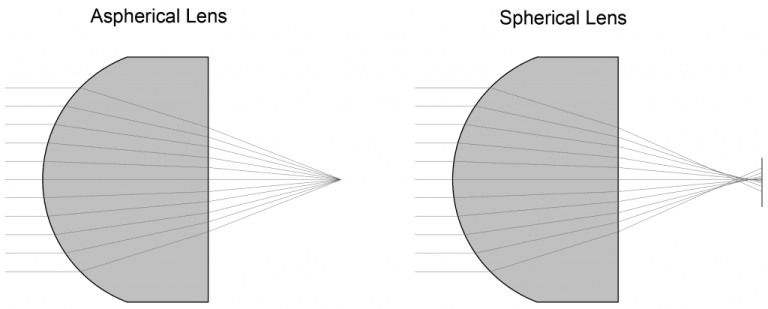
Aspheric vs. High-Index and Pancake Lenses – While high-index lenses use material properties to improve light bending, aspheric lenses optimize surface geometry for superior aberration correction. Compared to compact pancake lenses, aspheric lenses deliver significantly better edge-to-edge image clarity and reduced distortion.
Advanced Surface Geometry & Freeform Capabilities – Avantier supports both rotationally symmetric and freeform aspheric designs. These profiles feature curvature that varies with radial distance from the optical axis, offering greater flexibility in correcting complex aberrations. Key surface profile metrics include:
- Qbfs – RMS slope departure from a best-fit sphere
- Qcon – Sag departure from a base conic
Structure of an Aspheric Lens
Aspheric lenses are optical elements with a radially varying curvature, allowing them to correct aberrations more effectively than spherical lenses. Unlike traditional lenses with uniform curvature, aspheric surfaces are designed to bring light to a sharper, more precise focus.
These lenses are widely used in:
- Automotive sensors
- LED optics
- Medical imaging
- High-resolution cameras
- Laser systems
The surface of a rotationally symmetric asphere is mathematically defined using a sag equation:

Where:
- Z: sag of surface parallel to the optical axis
- s: radial distance from the optical axis
- C: curvature, inverse of radius
- k: conic constant
- A4, A6, …: 4th, 6th, … order aspheric coefficients
When all coefficients are zero, the surface is a standard conic shape—elliptical, parabolic, or hyperbolic, depending on the value of k.
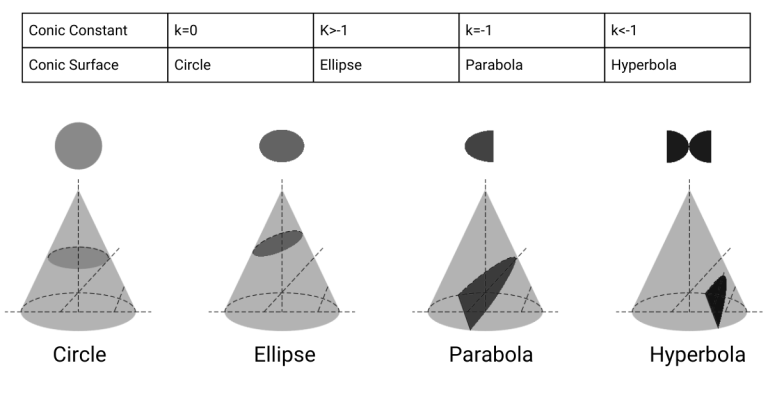
Spherical vs. Aspheric Performance Comparison
As shown in the chart below, a 25 mm f/1 spherical lens produces significantly larger spot sizes compared to an equivalent aspheric lens:
| Object Angle (°) | Spherical Spot Size (μm) | Aspheric Spot Size (μm) |
| 0.0 | 710.01 | 71.43 |
| 0.5 | 710.96 | 3.91 |
| 1.0 | 713.84 | 8.11 |
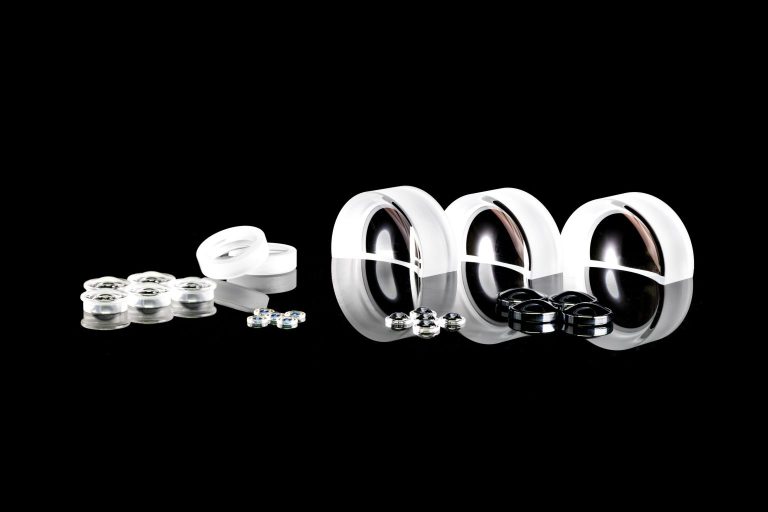
MTF Comparison: All Spherical vs. Aspheric Triplet Design
This table compares the Modulation Transfer Function (MTF) performance of two triplet lenses—one with only spherical surfaces, and the other with a single aspheric surface:
| Object Angle (°) | All Spherical (Tangential/Sagittal) | With Aspheric (Tangential/Sagittal) |
| 0.0 | 13.3 / 13.3 | 61.9 / 61.9 |
| 7.0 | 14.9 / 14.9 | 31.1 / 40.9 |
| 10.0 | 17.3 / 14.8 | 36.3 / 41.5 |
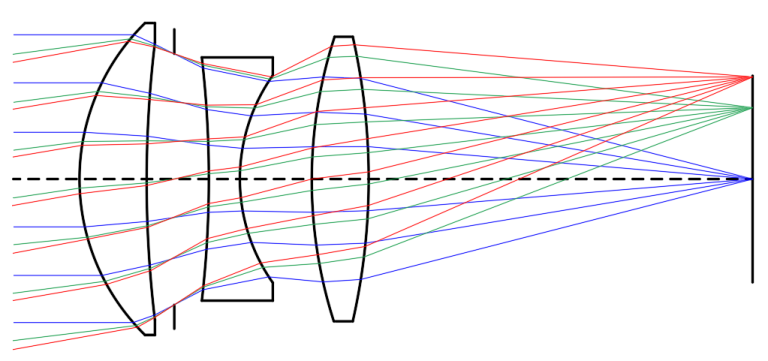
Avantier measures and controls all critical aspects of surface accuracy:
- Form Error – Large-scale deviations, RMS or peak-to-valley
- Waviness – Mid-frequency undulations (slope error)
- Surface Roughness – High-frequency texture, relevant for scatter & laser performance
- Radius Error – Curvature deviation corrected by focus tuning
Manufacturing Methods at Avantier
| Method | Benefits |
| Precision Glass Molding | Cost-efficient for high-volume production |
| Precision Polishing & MRF | High-precision shaping for low-to-medium volume applications |
| SPDT Diamond Turning | Excellent for plastics, metals, mold creation & freeforms |
| Polymer Molding/Injection | Lightweight, low-cost optics for AR/VR, illumination, and consumer |
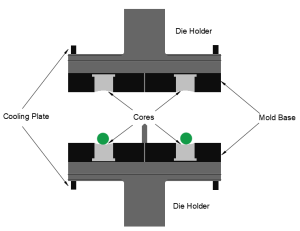



How to Select the Right Aspheric Lens for Your Application
Key Considerations
- UV, VIS, IR compatibility
- Coating options (AR, IR, broadband)
- Mechanical integration (CAD, full prescription)
- Budget and production scale
Application-Based Lens Guide
| Application | Recommended Lens Type | Key Features |
| High-NA Imaging | Precision Polished Aspheres | Diffraction-limited performance, glass/plastic options |
| Laser & Volume Systems | Precision Molded Aspheres | Ideal for laser collimation, barcode, data reading |
| Broadband Color Correction | Color-Corrected Aspheric Lenses | Chromatic + spherical correction, hybrid designs |
| Thermal / IR Imaging | Infrared Aspheric Lenses | Ge/ZnSe/ZnS optics for MWIR, LWIR, thermal sensing |
In Summary
From compact mobile lenses to aerospace-grade optics, Avantier’s aspheric lens solutions are engineered for performance and flexibility. Whether you’re optimizing beam shape, minimizing distortion, or reducing system size, our custom and stock aspheres deliver unmatched optical value.
FAQs
How are the surfaces of aspheric lenses defined, and what are the manufacturing capabilities of Avantier?
Q: How are the surfaces of aspheric lenses defined, and what are the manufacturing capabilities of Avantier?
A: Aspheric lenses are defined by their surface profile, either by sag or orthogonal coefficients Qbfs and Qcon. Avantier employs state-of-the-art grinding and polishing equipment, including computer-controlled precision polishing devices and magneto-rheological finishing (MRF) technology, ensuring optimized surface quality. Manufacturing capabilities include diameters ranging from 5 to 200mm, precise tolerances, and various surface quality options.
How have advances in manufacturing made aspheric lenses more versatile and cost-effective?
Q: How have advances in manufacturing made aspheric lenses more versatile and cost-effective?
A: Advances in manufacturing have made aspheric lenses more affordable and versatile, allowing them to replace multiple spherical lenses in various applications. This results in cost-effective and high-performance optical systems, expanding the range of applications from smartphones to lasers and fiber optics, as demonstrated by Avantier’s wide variety of manufactured aspheric lenses.
What types of custom aspheric lenses does Avantier manufacture?
Q: What types of custom aspheric lenses does Avantier manufacture?
A: Avantier, as an aspheric lens manufacturer, produces a diverse range of custom aspheric lenses solutions tailored for various applications. These applications span from smartphones to lasers, fiber optics, and extend to areas such as research, industry, and medicine.Related Content
WE CAN HELP YOU!
Contact us NOW for sales & expert advice.



